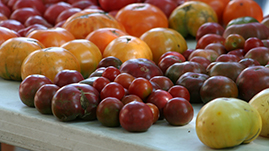Teachers' Domain - Digital Media for the Classroom and Professional Development
User: Preview



Economics determine where people live, how they earn a living, and what products they buy and use. Thinking about what we eat, how it is produced, and where to purchase it not only influences personal food choices, but also affects our overall economy. Over time, individual economic choices related to food have profound effects on the agricultural industry.
Our decisions about food sources also affect what stores buy and sell, whether it’s gardening tools, seeds, and mulch or fresh produce. When we examine our own food choices and those of family and friends, we can begin to understand the impact of personal decisions on economic factors such as supply and demand, production, competition, specialization, and opportunity cost.
In contemporary U.S. culture, “buy local” has become a common slogan emphasizing concerns for healthy food and a careful use of natural resources such as land, fuel, and water. Exploring why consumers might decide to “buy local” provides a chance to learn about the benefits of diets rich in fresh vegetables and fruits, how geography and climate are related to food production, and the complexity of eating a diverse diet without depleting natural resources.
A subset of “buying local” is the decision to grow our own food. Whether people raise tomatoes in container gardens, plant beans in backyard plots, or become involved in a community or school garden, they are making economic choices based on their wants and needs. People need healthy, high quality food to eat. They want this food to be readily accessible and affordable. And more and more, they want to know how their food is grown.
Many people grow gardens simply because of the economic issue of competition. It is difficult to find produce that rivals that grown in a backyard garden. The ripe, juicy tomatoes of an August garden seem like distant cousins to the crunchy, flavorless tomatoes available year round. The pleasure of taking fresh, homegrown vegetables straight from the garden to the dinner table is hard to match. The quality of that harvest and the yearlong benefit it brings through the practices of canning or freezing produce makes gardening an annual choice for many people.
Gardening provides many lessons in economics and everyday consumer choices from the tools and seeds needed to grow fruits and vegetables to the labor involved in planting, weeding, and harvesting to the farmers markets, restaurants, and groceries where produce is distributed and sold.
 Loading Standards
Loading Standards